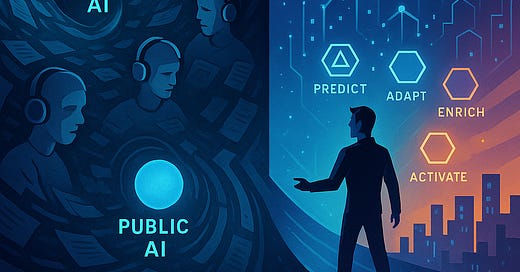May the Fourth Be With Your Decisions: Escaping the AI Echo Chamber
The Hidden Risks of Relying on Public Models & How AI-First Organizations Are Building Compounding Decision Intelligence While Competitors Fall to the Dark Side
Not long ago, using ChatGPT felt like discovering a secret weapon. Overnight, tasks that usually stretched over days—writing content, crafting strategy docs, replying to customers—were done in minutes. It was slick, fast, and easy to justify.
But there's a catch. The more we all lean on the same models, the more the output starts to blur together. It’s all beginning to sound... eerily identical.
And that’s only the surface.
Public LLMs like ChatGPT are now ingesting their own outputs—text spun up by other AIs. It’s a feedback loop that feeds on itself. These models become stuck in a hall of mirrors, gradually losing the quirks and fringe cases that once made them so capable. This is what researchers call model collapse—and it’s already unfolding.
For companies that hinge their customer experience, content, or decision-making on these tools, that’s not a glitch—it’s a massive blind spot.
When the AI Hype Meets Real-World Decisions
Why leaning too hard on public models is backfiring
At first, the race was on. Teams became AI-savvy overnight. Everyone had a bot, everyone automated a process.
But the honeymoon didn’t last. Outsourcing core decision-making to public models—or worse, slapping AI over your proprietary data without any guardrails—seemed smart until the cracks showed.
Now the damage is clear. Decisions lack bite. Insights feel thin. Strategy starts to echo what’s already out there. When every company leans on the same model trained on the same recycled inputs, originality fades—and with it, the competitive edge.
The Core Issue: Decision Sameness
Picture this: your team uses a public model to map out markets, anticipate customer behavior, or guide strategic shifts. So does your competitor. Same model. Same training data. Same blind spots.
And here's where it worsens. As these models keep retraining on AI-generated content, they drift from reality. They miss the subtle signals. They default to generic answers. And they make the same missteps—on repeat.
That’s not just inefficient. It’s a liability.
The Smarter Path: Compounding Decision Intelligence
The next generation of category leaders isn’t defined by whether they use AI—but by how they use it. The leaders are building something more resilient: compounding decision intelligence systems.
These are dynamic engines, constantly learning and refining decisions, fueled by your own data and sharpened by your team's expertise. Think beyond dashboards—this is about continuous decision loops. Not just measuring the past, but actively shaping the next move.
Here’s how it takes shape:
AI-Ready Data: Multi data graphs that feed decisions, reasoning, not just reports.
Proprietary Internal Data with curated external signals and Ontology
Knowledge Graphs: A living map of your business—its logic, relationships, customers.
Hybrid Architectures: Merging large language models with symbolic rule engines for balance.
Reinforcement Loops: Decision systems that grow smarter with every outcome.
This isn’t automation for automation’s sake. It’s intelligence that sharpens with each decision made.
Private AI Is the Engine—LoRA Is the Accelerator
Here’s where most companies miss the mark: you don’t need to reinvent the wheel. And you definitely don’t need to pour your most sensitive data into public APIs.
With Low-Rank Adaptation (LoRA), you can fine-tune open-source models—like LLaMA, Mistral, or Mixtral—specifically for your decision context. It’s fast, secure, and doesn't burn through your budget.
These models become the core of your decision engine. And they give you:
Control – Recommendations that follow your business logic, not internet noise.
Data Sovereignty – Your decision data stays with you, not in someone else's cloud.
Efficiency – Lightweight fine-tuning without the GPU inferno.
Think of it like owning your own factory for smarter decisions—and letting it refine itself every day.
Compounding in the Real World
Companies like Amazon no longer relies on meetings or hunch based debates to set prices or replenish inventory. They run autonomous systems that make those decisions in real time. Their “Hands off the Wheel” approach handed control to AI-driven loops years ago.
Banks are already operating with continuously learning systems that spot fraud and fine-tune portfolios without waiting for human review. Healthcare providers are adapting treatment protocols on the fly using real-time decision feedback.
Meanwhile, traditional orgs are still gluing decision tools onto old systems. The result? Sluggish moves. Slower learning.
Public Models Are a Dead End for Decision-Making
Let’s be blunt: if your decision stack is ChatGPT and a few plugins, you’re not leading you’re copying. Your insights? Off-the-shelf. Your choices? Predictable. Your strategy? Indistinguishable.
And it’s only getting worse. These public models are being retrained on more AI output, drifting further from real-world context. It’s a loop, and it’s warping decision quality with every spin.
That’s not a tech stack. It’s a crutch. And it compounds in the wrong direction.
What Smart Decision-Makers Are Doing
Structuring decision-ready data from other first and third party enrichment
Building rich knowledge graphs that mirror business logic
Combining models with symbolic reasoning for depth and accuracy
Using outcome-driven feedback to constantly refine decision engines
Fine-tuning private models for control and efficiency
Moving beyond dashboards to deploy autonomous decision agents
This Is Decision Intelligence That Compounds
This isn’t about cutting humans out, thats pretty critical but it’s about scaling intelligence. This shift isn’t just about AI. It’s about speed decision velocity. Making better choices, faster than the competition. Learning as you go, improving every cycle, scaling without stalling.
That’s compounding decision intelligence.
Each decision makes the system smarter. More tailored. More valuable.
The future won’t belong to whoever yells “AI” the loudest. It’ll belong to those building smarter systems - systems that learn quicker, think deeper, and evolve with every decision made.



